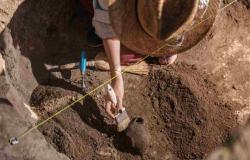A 10 square meter coconut fiber mat coupled with a metal mesh. The hope of restoring oxygen to the seas (and therefore to the planet) starts from here. They are the basis of the green carpet made from cuttings Posidonia oceanicathe endemic Mediterranean algae that plays a fundamental role in the ecosystem of Mare Nostrum: “It is a plant that forms underwater forests identical to terrestrial ones, it has the same ecological role. – he explains Monica MontefalconeAssociate Professor of Ecology at the University of Genoa, who a Bergeggia protected marine area a stone’s throw from the port of Vado-Savona, is the scientific responsible for the first reforestation intervention – which will be replicated on the Island of Elba in Puglia, in the Adriatic – of the Coop’s Blue Forests campaignmain sponsor of the initiative.
“80-90% of the oxygen in coastal waters is provided by this algae, which we are used to seeing beached on our beaches, but also as an exhibition it has a very important role in protecting the coasts from erosion, as they hinder the action and energy of the wave motion, contributing to the stability of the beaches and the coast” continues the teacher.
The similarities between posidonia meadows (which is a protected plant) and forests do not end here: just like trees with their roots, these algae reduce coastal erosion and stabilize the seabed.
“The impact on global warming of the destruction of plants that live under the surface of the water is less visible and certainly less media coverage than that of trees, but at least as much if not more devastating. Yet everyone is talking about the Amazon, while the loss of algae is a problem felt only by specialists. This is not only a technical challenge, but also and perhaps above all a cultural one” he declared Maura Latini President of Coop Italiaarrived at the Triton Club Diving of the small town in the province of Savona, for the presentation of the campaign and for the practical demonstration of the production of the mats of cuttings, which were then anchored to the seabed of the protected marine area of the island of Bergeggi.
A complex challenge, we were saying, and this is why Coop has brought together many partners to complete it: from Lifegate, to the European Institute for Innovation and Sustainability EIIS (which creates a community of activists under 35, involved in courses and experiences at sea on underwater biodiversity) to the university, to professional divers and biologists including teachers and experts from the ISSD, the International School for Scientific Diving, a non-profit association and the first Italian school for training underwater scientific researchers. And, finally, to members and customers, who will be able to participate by purchasing Sanseveria seedlings from 8 June: 1 euro for each plant purchased will be donated to the Blue Forest project.
The creation of mats for reforestation is an artisanal work: the seagrass cuttingscollected at sea among those eradicated due to storm surges, uncontrolled anchoring, trawling, are selected and then entered by hand: 20 cuttings in each 10 square meter structure. The mat is then anchored to the seabed by specialized divers in the areas identified as suitable by the technicians.
“Posidonia grows very slowly, in this way we help it. Once reforested, it takes 6 months to a year for the plants to take root and years for them to first begin to increase density and then expand and restore the prairie – he declares Stefano Acunto, Director ISSD International School for Scientific Diving, the “inventor” of the system. “However, it is necessary that the causes of death of the algae have disappeared first, the most important of which is the overbuilding of the beaches”.
Doing the math, you can see how the Coop project, worth 200 thousand euros, is really a drop in the ocean: the cost of 100 square meters of reforestation is around 20 thousand euros.
Blue Forest involves the laying of 200 m2 of mats around the Ligurian island and the same number in the other two areas identified, against “a loss of over 20 hectares in the Bergeggi area. And in Italy over the years the extension of seagrass has decreased by half”, concludes Montefalcone, who in addition to the figures of the problem, he also rattles off the numbers why every initiative, small or large, is important: “Every square meter of prairie can generate daily 4 to 20 liters of oxygen and represents an ideal habitat for biodiversity and a chosen place for reproduction and nursery. Its presence helps the underground storage of carbon dioxide and its leaves are permanent home for approximately 25% of Mediterranean marine species“.
Maura Latini closes: “It is a challenge, we realize it, the results of which cannot be predicted, but we know that sow innovation and knowledge today is the most profitable way to reap fruits tomorrow.”
v






